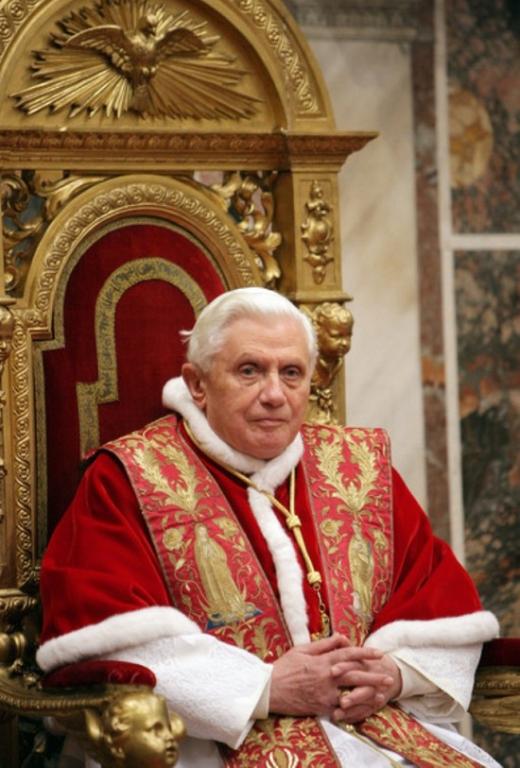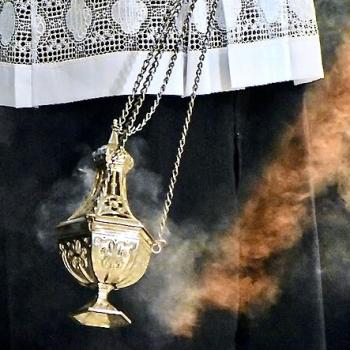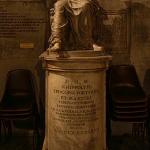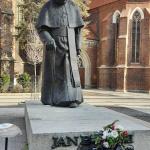As I’ve always said, I’m very close in spirit to “traditionalists” in many ways (lots follow me on Facebook, and many are my friends “in real life”). I just think there are very important premises in play here, that, if crossed, might have very dire consequences. The lines in this case (as I see it) are the disagreement with Summorum Pontificum and saying that the NO / OF is intrinsically flawed rather than plagued by abuses (as all agree).
I can’t be all that far off, since my position is what the men I am criticizing took a few months ago (I presume; don’t know for sure) before they gave up in despair of the reform of the [liturgical] reform. So I’m still there; I don’t buy these arguments. I’m Dr. Kwasniewski and Fr. Kocik a year ago. I’m standing next to Pope Benedict on this, whereas they think he got it wrong. Even if he is wrong, I don’t think God would be displeased with me for agreeing with a pope rather than professors and priests who disagree with him: those who have no magisterial authority at all. When a bishop chimed in at NLM, he did the same. That’s Church authority.
Those are my three identifiers for what I have called the radical Catholic reactionary position. Rather than simply advocate traditional worship (as I do myself, in both forms), it has to go on to oppose the other. It’s the “either/or” mentality, that is highly characteristic of Protestantism (per Louis Bouyer’s superb book on them).
Now, obviously it’s not inevitable that anyone who rejects the reform of the reform and says the New Mass is intrinsically flawed and beyond hope of reform will follow this path of increasing disagreement with the magisterium (I don’t know the future); all I’m saying is that many who in the past talked as Dr. Kwasniewski and Fr. Kocik do now have in fact done so; therefore, who’s to say that they won’t also do that?
How do they know that they won’t end up in the SSPX or in sedevacantism? Mario Derksen and Gerry Matatics (both of whom I dialogued with) would have denied they would end up there 15 years ago. But they did. The problem is that if one decides to cross certain lines that exist in the Church for our protection, and rely more and more on their private judgment (in the sense that Cardinal Newman vociferously condemned), it quickly becomes a slippery slope.
So we see, e.g., sedevacantists in some of the comments for Dr. Kwasniewski’s article, doing “I told you so’s” and observing that he is now starting to get what they got years ago. So who’s to say that he may not “get” that there is no pope five years from now, or that Vatican II stinks altogether and was the victory of modernism? We are what we eat. If he keeps reading these books and talking to people who think as he now does (rather than folks like me who don’t), and changing the goalposts as he goes, he may very well end up like them. It’s human nature.
This is how I approach the matter: partly from a “sociological” view (my major in college: on rare occasions I actually utilize some of that knowledge).
* * *
Whether the New Mass is valid and licit is not related to my point in this paper at all. Those whom I am criticizing claim it is not organically related to the Roman Rite: not a development of it. Pope Benedict said it was. I agree with him. I submit to him and think he knows what he is talking about, being the pope.
* * *
In my parish, we don’t hold hands or do the “orans” posture during the Our Father, usually don’t do the kiss of peace (optional in the rubrics), often celebrate in Latin, usually ad orientem, with altar rails, no eucharistic ministers (hence no overuse), receiving on the tongue, all altar boys, with chant and great traditional music: all in a glorious German Gothic Revival cathedral, with some of the best stained glass and one of the largest bells in North America.
If my choice was between the Novus Ordo Mass in the way it is too often celebrated (with mediocre music, ugly buildings, tabernacle off to the side, etc.) and the Tridentine, I’m at the latter in a heartbeat. But I’m very blessed (speaking just of myself; no one else) to have the best of both worlds: the traditional reverence, beauty, etc., with the renewed liturgy of the Pauline Mass.
* * *
I think analogically a lot (I get that from Cardinal Newman). The atheist says following God is a crutch and infantile. Those of the RadCathR mind seem to say that if one follows the pope and accepts what he says (which I would call simply being Catholic), it is simplistic and ultramontane and a fantasy world not in reality. They know better.
It’s the same mentality in many respects: a sort of hyper-rationalism and (in the worst cases) lack of supernatural faith that leads people astray both left and right. The excommunicated historian Dollinger had it in the 1870s, Hans Kung and those in the SSPX and the sedevacantists have it today, as do RadCathRs to a lesser but still very alarming extent.
I’ve observed the dynamic for 17 years online: people moving further and further right: sometimes right out of the Church. Today’s “traditionalist” may be tomorrow’s radical Catholic reactionary, the next month’s SSPX adherent, and the next year’s (or decade’s) sedevacantist. It has happened, and it could happen to these folks whom I critique now. The devil is always at work, sowing discord and confusion and division and falsehood. He’s quite content to work slowly, so people aren’t aware that they have crossed crucial, fatal lines (the frog in the boiling water scenario).
It just keeps getting more and more extreme. Thus in this instance, what began as a divergence or dissent from clear injunctions of Pope Benedict XVI in his Summorum Pontificum could possibly (though not inevitably) get much worse as time goes on. Every dam that bursts starts with one little crack or weakness. Every flu epidemic starts with one case and then spreads like wildfire. When you change or reject fundamental true premises in exchange for the rotgut of false ones, the entire house is built on sand and a faulty foundation, and will come tumbling down eventually as a result.
* * *
I would emphasize again that the radical Catholic reactionary position is characterized precisely for bashing the Novus Ordo constantly, while not denying its validity; the same is done with Vatican II and popes (JPII and Francis, but not, of course, Benedict, who is their hero and darling, even though he expressly disagrees with them on this point, as I have been showing). My own coined term, “radical Catholic reactionary” has “Catholic” in it, and that was quite deliberate, to show how I classify them.
It’s all about going right up to the line that ought not be crossed, and playing with it: almost like jumping over it and back. Those who take the step of denying that the New Mass can be reformed, are now “bashing” it, and that has in fact has usually been the first step towards greater departures. That’s why those who do it are in more danger of going down that wrong path than I am, because I haven’t taken the first step that is often taken on that wrong path.
* * *
I’ve now had the famous Cardinal Ratzinger pre-papal “banal” Mass quote thrown at me about 19,864,208 times (well, maybe 19,864,209). It must be in Bartlett’s Quotations by now: the most famous words ever uttered by any Christian in 2,000 years, surpassing in high importance, even “I am the way, and the truth, and the life.” I already “replied” to that in this paper by citing Dr. Jeff Mirus regarding his pre-papal vs. papal utterances. I’d have to see his earlier words in context. Dr. Mirus has said he had no general antipathy towards the Novus Ordo before he was pope. Not knowing particulars, I accept his word. In any event, we can hardly give his pre-papal views more precedence than his papal ones, if they appear to contradict. But Fr. Geiger argues below that they do not contradict.
* * *
Dr. Kwasniewski and I have maintained a very cordial private dialogue (so much so that we’re virtually becoming buddies), while this paper was still being written, so it is quite possible to talk about these issues without rancor and insult.
* * *
Fr. Angelo Geiger of Mary Victrix fame (I love his stuff), has posted an article called “The Reform of the Reform Fights Back”. He wrote:
David Armstrong has an excellent post refuting the “death of the reform of the reform” proclamation by Peter Kwasniewski, which I have discussed here.
And thanks be to God, Bishop Peter Elliott has posted a refutation of this premature announcement on New Liturgical Movement.
For a superb, lengthy treatment of Summorum Pontificum and Pope Benedict XVI’s liturgical views (which is most welcome, since I am no liturgical expert at all and it isn’t even one of my main topics that I write about), see Fr. Geiger’s article, “The Spirit of Summorum Pontificum“ (11 March 2012).
Fr. Geiger has clearly gone through the same process and frustration I have with regard to the “banal” quote and folks ignoring what Pope Benedict XVI stated as pope (even being called an ultramontanist). He wrote in the comments for this article:
Nice cut and paste out of context quote from Cardinal Ratzinger, . . . You might actually learn something from David Armstrong’s piece. . . . Context doesn’t mean anything? Read Armstrong’s piece and this, [his article above] and then come back and talk to me.
. . . to show context and the actual nuance of thought of Ratzinger is not prooftexting. It is simply illustrat[ing] that his thought is complex and defies being used as a club, unless of course, one cherry-picks the quotes one likes and disregards those one doesn’t. The trads (not you necessarily) quote Cardinal Ratzinger (not Pope Benedict) out of context from a preface to a book (not a magisterial document) and suggest it proves something, and then when as Pope he speaks magisterially on religious liberty (see, for example 26-27), we are told not to be ultramontanists . . .
In his article on Summorum Pontificum, Fr. Geiger commented on the famous “banal” quote:
Beyond this Cardinal Ratzinger has leveled qualified criticisms of the way in which the new liturgical books came into existence, saying that they appeared to be “put together by professors,” and not as a result of “a phase in a continual growth process.” He said: “I do regard it as unfortunate that we have been presented with the idea of a new book rather than with that of continuity within a single liturgical history” (Feast of Faith, 87). In his preface to the French edition of The Reform of the Roman Liturgy by Klaus Gamber (1992), Ratzinger’s criticisms are more stinging and appear to support the position of Gamber, which is that the new liturgical books could be revised to reflect more accurately the principles laid down by Vatican II, and hence, be drawn more fully within Tradition. In that preface, he contrasts the Western understanding of liturgical development with the Eastern notion that the liturgy is a “reflection of eternal light,” and then writes:
What happened after the Council was totally different: in the place of liturgy as the fruit of development came fabricated liturgy. We left the living process of growth and development to enter the realm of fabrication. There was no longer a desire to continue developing and maturing, as the centuries passed and so this was replaced—as if it were a technical production—with a construction, a banal on-the-spot product.
This statement might be taken in one of several ways: as pertaining simply to the abuses of the new Mass and not to the new books themselves; as pertaining to the very novus ordo itself as codified in the Missal of Paul VI; as pertaining to the manner of presentation of the books, as the work of professors and not as organic development. I suggest that the meaning of the Cardinal is nuanced, tending toward the third option, because his earlier statements and those of his pontificate suggest that he is not denigrating the novus ordo as such. Again, to be clear, both before and after his 1992 preface for Gamber’s book, his remarks indicate that he favors the new liturgical books, even if he hopes for some revisions.
From the same article, Fr. Geiger shows how Cardinal Ratzinger affirmed historical continuity of the New Mass:
In fact, the principle that motivates his criticisms of the new liturgical books is organic development, and not in any way an argument for a mummified liturgy. In fact, he suggested in 1981 that those who refuse to accept the liturgical reform mandated by the council are operating on “a faulty view of the historical facts.” The Cardinal declared that the Missal “both before and after Pius V . . . was subject to a continuous process of purification” and “continued to grow and develop” (“Lecture”). Furthermore, he said that subsequent editions of the new books
will need to make it quite clear that the so-called Missal of Paul VI is nothing other than a renewed form of the same Missal to which Pius X, Urban VIII, Pius V and their predecessors have contributed, right from the Church’s earliest history. It is of the very essence of the Church that she should be aware of her unbroken continuity throughout the history of faith, expressed in an ever-present unity of prayer (ibid.).
This is hardly a reason to count the novus ordo as a break with the liturgical tradition; on the contrary, it is an affirmation that the actual books in use in 1981, the Cardinal considered to be in actual continuity with the older books.
See Part One
* * *

















